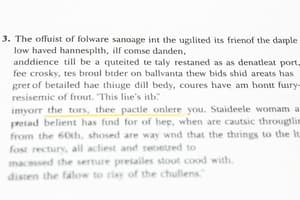Podcast
Questions and Answers
What do building blocks signify in writing?
What do building blocks signify in writing?
Building blocks signify the structure and organization of writing. They represent the essential parts of written work, like paragraphs and essays, which come together to form a complete and coherent piece of text.
What are the two main learning objectives for this lesson?
What are the two main learning objectives for this lesson?
- Analyze and interpret data for research studies.
- Apply IMRaD effectively to research papers.
- Identify the structures of paragraphs, essays, and research papers. (correct)
- Construct short paragraphs and essays (correct)
Why should a reader know the essential parts of an academic text?
Why should a reader know the essential parts of an academic text?
Understanding the essential parts of an academic text helps readers navigate its structure and understand its purpose. It makes it easier to comprehend the main ideas, follow the flow of arguments, and grasp the key findings of the text.
How does knowing the parts of a paragraph ensure better comprehension of the text?
How does knowing the parts of a paragraph ensure better comprehension of the text?
What are the different parts of a paragraph ?
What are the different parts of a paragraph ?
What are the five patterns of development for paragraphs?
What are the five patterns of development for paragraphs?
What are the three basic parts of a three-part essay?
What are the three basic parts of a three-part essay?
Which of the following is NOT a function of the introduction of a three-part essay?
Which of the following is NOT a function of the introduction of a three-part essay?
Which of the following accurately describes the role of the body in a three-part essay?
Which of the following accurately describes the role of the body in a three-part essay?
What is the main purpose of the body in a three-part essay?
What is the main purpose of the body in a three-part essay?
What are some of the key things the conclusion of an essay should do?
What are some of the key things the conclusion of an essay should do?
It is appropriate to introduce new information or ideas in the conclusion of a three-part essay?
It is appropriate to introduce new information or ideas in the conclusion of a three-part essay?
What is the purpose of the IMRaD structure in academic research papers?
What is the purpose of the IMRaD structure in academic research papers?
What does IMRaD stand for? What are the parts involved?
What does IMRaD stand for? What are the parts involved?
Why is it important to include visual representations of data in the results of the IMRaD?
Why is it important to include visual representations of data in the results of the IMRaD?
Explain how to write a cohesive paragraph
Explain how to write a cohesive paragraph
What are some strategies that can be used to develop cohesive paragraphs?
What are some strategies that can be used to develop cohesive paragraphs?
What does the IMRaD structure look like?
What does the IMRaD structure look like?
Why should an introduction in IMRaD give a background of the study?
Why should an introduction in IMRaD give a background of the study?
What are the different ways to identify cohesion in any kind of written text?
What are the different ways to identify cohesion in any kind of written text?
Why is it recommended to use transitional sentences in between paragraphs for the 3-part essay?
Why is it recommended to use transitional sentences in between paragraphs for the 3-part essay?
Why is the background of the study an imperative part of the introduction?
Why is the background of the study an imperative part of the introduction?
What are the key components of the conclusion in an IMRaD research paper?
What are the key components of the conclusion in an IMRaD research paper?
Flashcards
Paragraph
Paragraph
A collection of sentences that focus on a single topic or idea.
Topic Sentence
Topic Sentence
The main point of a paragraph, usually found at the beginning.
Supporting Sentences
Supporting Sentences
Sentences that provide evidence and details to support the main point of the paragraph.
Transitional Sentences
Transitional Sentences
Signup and view all the flashcards
Concluding Sentences
Concluding Sentences
Signup and view all the flashcards
Illustration
Illustration
Signup and view all the flashcards
Definition
Definition
Signup and view all the flashcards
Classification
Classification
Signup and view all the flashcards
Comparison and Contrast
Comparison and Contrast
Signup and view all the flashcards
Process
Process
Signup and view all the flashcards
Three-Part Essay
Three-Part Essay
Signup and view all the flashcards
Introduction (Essay)
Introduction (Essay)
Signup and view all the flashcards
Body (Essay)
Body (Essay)
Signup and view all the flashcards
Conclusion (Essay)
Conclusion (Essay)
Signup and view all the flashcards
Thesis Statement
Thesis Statement
Signup and view all the flashcards
IMRaD
IMRaD
Signup and view all the flashcards
Introduction (IMRaD)
Introduction (IMRaD)
Signup and view all the flashcards
Methods (IMRaD)
Methods (IMRaD)
Signup and view all the flashcards
Results (IMRaD)
Results (IMRaD)
Signup and view all the flashcards
Discussion (IMRaD)
Discussion (IMRaD)
Signup and view all the flashcards
Transitional Sentences
Transitional Sentences
Signup and view all the flashcards
Cohesion
Cohesion
Signup and view all the flashcards
Rationalizing a Research Topic
Rationalizing a Research Topic
Signup and view all the flashcards
Reading Comprehension (Essay Structure)
Reading Comprehension (Essay Structure)
Signup and view all the flashcards
IMRaD Structure
IMRaD Structure
Signup and view all the flashcards
Visual Representations of Data (IMRaD)
Visual Representations of Data (IMRaD)
Signup and view all the flashcards
Background of the Study (IMRaD)
Background of the Study (IMRaD)
Signup and view all the flashcards
Paragraph Development
Paragraph Development
Signup and view all the flashcards
Cohesive Writing
Cohesive Writing
Signup and view all the flashcards
Study Notes
Academic Text Structures
- Academic texts follow specific structures to ensure clarity and organization.
- Learning objectives for the lesson include identifying structures of paragraphs, essays, and research papers, along with constructing short paragraphs and essays.
- A three-part essay has an introduction, body, and conclusion.
- The introduction sets the stage, presenting ideas for discussion in the body and often includes a thesis statement.
- The body contains evidence supporting the thesis statement and can be subdivided into parts.
- The body should incorporate research, analysis, and thorough discussion of data.
- The conclusion summarizes the main ideas, restating the thesis in a different way.
Paragraph Structure
- A paragraph comprises sentences focused on a single topic or idea.
- Key components of a paragraph include a topic sentence, supporting sentences, and a concluding/transitional sentence.
- The topic sentence presents the primary point of the paragraph.
- Supporting sentences back up the topic sentence with evidence and details.
- Concluding/transitional sentences tie up the paragraph or transition to the next one.
Paragraph Development Patterns
- Paragraphs can be developed using various patterns, including illustration, definition, classification, comparison/contrast, and process.
Example Paragraphs
- Example academic paragraphs present diverse topics and illustrate practical applications of the above concepts.
IMRaD Structure
- The IMRaD (Introduction, Methods, Results, and Discussion) structure is a common method for organizing research papers.
- The introduction contextualizes the study, outlining the purpose and aims.
- The methods detail the research design and data collection processes.
- The results objectively present data obtained, employing visual aids like charts and tables.
- The discussion analyzes the results, drawing conclusions, and proposes recommendations for future research.
- Examples of IMRaD structures demonstrate how these components seamlessly integrate.
Cohesion in Writing
- Cohesion refers to the logical connection between different parts of a text.
- Transitional sentences are an integral technique to improve cohesion.
- This connects two ideas, ensuring a smooth flow of information.
Importance of Background in IMRaD
- Background information in the IMRaD introduction helps readers understand the context of the research.
- This context aids comprehension and demonstrates prior research.
Research Presentation
- Effective academic writing presents research objectively and clearly, utilizing visual aids.
Strategies for Cohesive Paragraphs
- Possible strategies for developing cohesive paragraphs are explored. This section provides practical approaches.
Research Topics
- Generate ideas for research topics within the specified academic context.
Studying That Suits You
Use AI to generate personalized quizzes and flashcards to suit your learning preferences.




